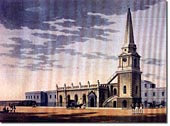
| Religion played an essential role in the lives of the British. The further they strayed from home, the more comfort they could receive from the familiarity and conservatism of the institution. Births, marriages and deaths are essential rites of passage for all christians. It would have been difficult to entice servants of the crown (and their families) to foreign climes without providing some sort of ability to practice these rites. People were very religious in these times and would have felt ill at ease at being unable to pray and receive communion in a church after any significant period of time. The Church of England would have received official sanction and encouragement to establish churches in major areas of European habitation. However, the other minority churches would also have been quick to provide religious facilities for their followers and they would also have been keen to try and make new converts. We are fortunate that many of the churches of the imperial era have survived into modern times. A combination of historic pictures and recent photographs allow us to see the remains of this essential imperial institution. For those people who are British, or who know Britain well, these pictures should conjure up familiar associations of typical English villages and a pastoral way of life that can still be found in many corners of the country. These are the same sorts of associations that the original builders and designers of these structures would have wanted to recreate: Trying to create a home from home. Take a look at the following pictures and see if you agree: |
 |
 |
|
| Malcolm Heppolette's Pictures | Kerry Edwards' Contributions | |
 |
||
| Peter Charlesworth's Pictures | ||
 |
 |
|
| Syd Buxton's Pictures | Kurseong Church |
Armed Forces | Art and Culture | Articles | Biographies | Colonies | Discussion | Glossary | Home | Library | Links | Map Room | Sources and Media | Science and Technology | Search | Student Zone | Timelines | TV & Film | Wargames
